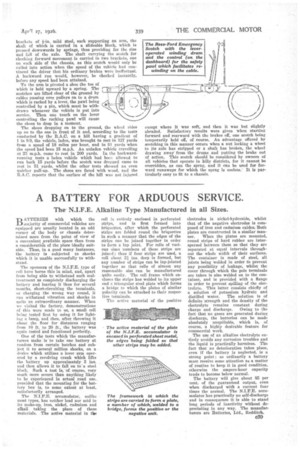OFFICIAL TEST OF AN EMERGENCY SCOTCH.
Page 22

Page 23

If you've noticed an error in this article please click here to report it so we can fix it.
A Newly Patented Scotching System, Definite in Action, which has Behaved Well Under Test
THE use of the scotch or skid pan as an ordinary method of braking a vehicle is, not unreasonably, regarded with disfavour byhighway authorities because of the risk of abrasion of the road surface, but it would ' be regarded as the lesser of two evils if it were employed to avert the threat of a serious accident. It may be assumed, for example' that some of the many mishaps to motor coaches that have occurred since the war and to goods vehicles at different times would have been averted had the vehicles been equipped with scotches of this order and had they been put into action at the right time.
In our issue of February 9th we described, from the recently published patent specification, a scotch which did not at the time make a great impression upon us, but the inventors have now shown UR their working drawings and have described the tests carried out by them and those conducted by the Royal Automobile Club, and have explained away the chief points of objection as they originally occurred to us. The scotches when lifted out of contact with the ground are hidden behind the valance of a motor coach, whilst, in the case of a goods vehicle, they could not be described as eyesores. The weight is not very great, yet the parts can be made amply strong for the duty imposed upon them. Weight, again, is less than we had thought, because it was discovered in the course of the tests that the scotching of both rear wheels is not practicable. as steering control is then lost. Hence only one pair of scotches, forward and ,backward, acting on one wheel, is used.
C38
The invention is that of Messrs. Rees and Ford, of 9, Donald Street, Abercanaid, Merthyr Tydfil, South Wales. Bolted to the frame of the chassis are two hanger
brackets of fin, mild steel, each supporting an arm, the shaft of which is carried in a slidesible block, which is pressed downwards by springs, thus providing for the rise and fall of the axle. The shaft carrying the scotch for checking forward movement is carried in two brackets, one on each side of the chassis, as this scotch would only be called into action when the speed of the vehicle had convinced the driver that his ordinary brakes were ineffectual. A backward run would, however, be checked instantly, before any speed had been attained.
To the arm is pivoted a shoe the toe of which is held upward by a spring. The scotches are lifted clear of the ground by cables passing over pulleys on to a drum which is racked by a lever, the pawl being controlled by a pin, which must be withdrawn whenever the vehicle is put into service. Then one touch on the lever controlling the racking pawl will cause the shoes to drop in a moment.
The shoes dropping on to the ground, the wheel rides up on to the one in front of it and, according to the tests conducted by the R.A.C. on a hill having a gradient of 1 in 9.9, the vehicle, laden, Was brought to rest in 127 yards from a speed of 18 miles per hour, and in 91 yards when the speed had been 15 m.p.h. An unladen vehicle travelling at 23 m.p.h. came to rest in 200 yards. In the backwardrunning tests a laden vehicle which had been allowed to run back 15 yards before the scotch was dropped came to rest in 51 yards, whilst the other tests showed an even quicker pull-up. The shoes are faced with wood, and the R.A.C. reports that the surface of the hill was not injured
except where it was soft, and then it was but slightly abraded. Satisfactory results were given when starting forward and rearward with the brakes off, one scotch being temporarily held off, of course. An advantage offered by scotching in this manner occurs when a nut locking a wheel to its axle has stripped or a shaft has broken, the wheel drawing away' from the drums and putting the brake out of action. This scotch should be considered by owners of all vehicles that operate in hilly districts, for it cannot be overridden, as can the sprag, and it can be used for forward runaways for which the sprag is useleas.' It is particularly easy to fit to a chassis.
































